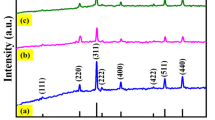Abstract
A new approach for the highly sensitive detection of dopamine by a novel composite film involving gold nanoparticles trapped in a negatively-charged fluorocarbon polymer (Nafion) on a glassy carbon (GC) electrode fabricated by a simple method is described. Gold nanoparticles with an average diameter of 2.3 nm ± 0.2 nm are dispersed throughout the whole Nafion film. The introduction of gold nanoparticles into the Nafion film not only gives a highly active electrode surface area but also increases the conductivity of the Nafion film and the resulting Au/Nafion/GC electrode combines the advantages of the properties of gold nanoparticles and the selective pre-concentration ability of Nafion. For positively charged dopamine, the results show a decrease in the redox peak separation and a high sensitivity. The oxidation peak current of dopamine was shown to vary linearly with dopamine concentration over a wide range from 0.4 to 50.0 μmol/L with a detection limit of 0.3 μmol/L. Negatively charged ascorbic acid shows no redox waves at concentrations up to 1.0×10−4 mol/L.
Similar content being viewed by others

References
Harrison DJ, Turner RFB, Baltes HP. Characterization of perfluorosulfonic acid polymer coated enzyme electrodes and a miniaturized integrated potentiostat for glucose analysis in whole-blood. Anal Chem, 1988, 60: 2002–2007
Lin L, Qiu P, Yang L, Cao X, Jin L. Determination of dopamine in rat striatum by microdialysis and high-performance liquid chromatography with electrochemical detection on a functionalized multiwall carbon nanotube electrode. Anal Bioanal Chem, 2006, 384: 1308–1313
Dutt V, Mottola H. Determination of uric-acid at the microgram level by a kinetic procedure based on a pseudoinduction period. Anal Chem, 1974, 46: 1777–1781
Arrigoni O, De Tullio MC. Ascorbic acid: much more than just an antioxidant. Biochim Biophys Acta, 2002, 1569: 1–9
Welch CM, Compton RG. The use of nanoparticles in electroanalysis: a review. Anal Bioanal Chem, 2006, 384: 601–619
Duron S, Rivera-Noriega R, Nkeng P, Poillerat G, Solorza-Feria O. Kinetic study of oxygen reduction on nanoparticles of ruthenium synthesized by pyrolysis of Ru3(CO)12. J Electroanal Chem, 2004, 566: 281–289
Dickinson AJ, Carrette LPL, Collins JA, Friedrich KA, Stimming U. Preparation of a Pt-Ru/C catalyst from carbonyl complexes for fuel cell applications. Electrochim Acta, 2002, 47: 3733–3739
Xiang C, Zou Y, Sun LX, Xu F. Direct electrochemistry and enhanced electrocatalysis of horseradish peroxidase based on flowerlike ZnO-gold nanoparticle-Nafion nanocomposite. Sensors Actuat B, 2009, 136: 158–162
Thangavel S, Ramaraj R. Polymer membrane stabilized gold nanostructures modified electrode and its application in nitric oxide detection. J Phys Chem C, 2008, 112: 19825–19830
Pron’kin SN, Tsirlina GA, Petrii OA, Vassiliev SY. Nanoparticles of Pt hydrosol immobilised on Au support: an approach to the study of structural effects in electrocatalysis. Electrochim Acta, 2001, 46: 2343–2351
Liu Z, Lee JY, Han M, Chen W, Gan LM. Synthesis and characterization of PtRu/C catalysts from microemulsions and emulsions. J Mater Chem, 2002, 12: 2453–2458
Hu K, Lan D, Li X, Zhang S. Electrochemical DNA biosensor based on nanoporous gold electrode and multifunctional encoded DNA-Au Bio Bar codes. Anal Chem, 2008, 80: 9124–9130
Li J, Lin XQ. Electrodeposition of gold nanoclusters on overoxidized polypyrrole film modified glassy carbon electrode and its application for the simultaneous determination of epinephrine and uric acid under coexistence of ascorbic acid. Anal Chim Acta, 2007, 596: 222–230
Cai WY, Xu Q, Zhao XN, Zhu JH, Chen HY. Porous gold-nanoparticle-CaCO3 hybrid material: Preparation, characterization, and application for horseradish peroxidase assembly and direct electrochemistry. Chem Mater, 2006, 18: 279–284
Majid E, Hrapovic S, Liu YL, Male KB, Luong JHT. Electrochemical determination of arsenite using a gold nanoparticle modified glassy carbon electrode and flow analysis. Anal Chem, 2006, 78: 762–769
Kreuer KD. On the development of proton conducting polymer membranes for hydrogen and methanol fuel cells. J Membr Sci, 2001, 185: 29–39
Hong J, Ghourchian H, Rezaei-Zarchi S, Moosavi-Movahedi AA, Ahmadian S, Saboury AA. Nafion-methylene blue functional membrane and its application in chemical and biosensing. Anal Lett, 2007, 40: 483–496
Szentirmay MN, Martin CR. Ion-exchange selectivity of Nafion films on electrode surfaces. Anal Chem, 1984, 56: 1898–1902
Whiteley LD, Martin CR. Perfluorosulfonate ionomer film coated electrodes as electrochemical sensors — fundamental investigations. Anal Chem, 1987, 59: 1746–1751
Kavan L, Gratzel M. Nafion modified TiO2 electrodes-photoresponse and sensitization by Ru(II)-bipyridyl complexes. Electrochim Acta, 1989, 34: 1327–1334
Wang T, Hu JS, Yang W, Zhang HM. Electrodeposition of monodispersed metal nanoparticles in a Nafion film: Towards highly active nanocatalysts. Electrochem Commun, 2008, 10: 814–817
Cox JA, Poopisut N. Preconcentration of dopamine by uphill transport across an ion-exchange membrane. Anal Chem, 1992, 64: 423–426
Li J, Lin XQ. Electrodeposition of gold nanoclusters on overoxidized polypyrrole film modified glassy carbon electrode and its application for the simultaneous determination of epinephrine and uric acid under coexistence of ascorbic acid. Anal Chim Acta, 2007, 596: 222–230
Zhang H, Li N. Electrocatalytic response of dopamine at a DL-homocysteine self-assembled gold electrode. Microchemical Journal, 2000, 64: 277–282
Dayton MA, Ewing AG, Wightman RM. Response of microvoltammetric electrodes to homogeneous catalytic and slow heterogeneous charge-transfer reactions. Anal Chem, 1980, 52: 2392–2396
Author information
Authors and Affiliations
Corresponding author
Additional information
Support from the National Natural Science Foundation of China (Grant No. 20875008) is gratefully acknowledged.
Rights and permissions
About this article
Cite this article
Kong, L., Kan, M., Han, D. et al. Highly sensitive response to dopamine at a modified electrode involving a composite film with Au nanoparticles dispersed in a fluorocarbon polymer. Sci. China Chem. 53, 826–831 (2010). https://doi.org/10.1007/s11426-010-0117-9
Received:
Accepted:
Published:
Issue Date:
DOI: https://doi.org/10.1007/s11426-010-0117-9



